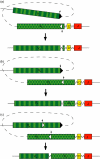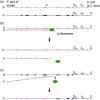V(H) replacement in rearranged immunoglobulin genes
- PMID: 15667560
- PMCID: PMC1782071
- DOI: 10.1111/j.1365-2567.2004.02084.x
V(H) replacement in rearranged immunoglobulin genes
Abstract
Examples suggesting that all or part of the V(H) segment of a rearranged V(H)DJ(H) may be replaced by all or part of another V(H) have been appearing since the 1980s. Evidence has been presented of two rather different types of replacement. One of these has gained acceptance and has now been clearly demonstrated to occur. The other, proposed more recently, has not yet gained general acceptance because the same effect can be produced by polymerase chain reaction artefact. We review both types of replacement including a critical examination of evidence for the latter. The first type involves RAG proteins and recombination signal sequences (RSS) and occurs in immature B cells. The second was also thought to be brought about by RAG proteins and RSS. However, it has been reported in hypermutating cells which are not thought to express RAG proteins but in which activation-induced cytidine deaminase (AID) has recently been shown to initiate homologous recombination. Re-examination of the published sequences reveals AID target sites in V(H)-V(H) junction regions and examples that resemble gene conversion.
Figures



Similar articles
-
Gene conversion in human rearranged immunoglobulin genes.Immunogenetics. 2006 Jul;58(7):511-22. doi: 10.1007/s00251-006-0113-6. Epub 2006 May 17. Immunogenetics. 2006. PMID: 16705406
-
VH replacement in mice and humans.Trends Immunol. 2007 Mar;28(3):132-7. doi: 10.1016/j.it.2007.01.003. Epub 2007 Jan 26. Trends Immunol. 2007. PMID: 17258935 Review.
-
Potential contribution of VH gene replacement in immunity and disease.Ann N Y Acad Sci. 2005 Dec;1062:175-81. doi: 10.1196/annals.1358.020. Ann N Y Acad Sci. 2005. PMID: 16461800 Review.
-
Immunoglobulin variable region gene analysis to the autoantibody-secreting B cells from tumors in association with paraneoplastic autoimmune multiorgan syndrome.Int J Dermatol. 2007 Nov;46(11):1146-54. doi: 10.1111/j.1365-4632.2007.03267.x. Int J Dermatol. 2007. PMID: 17988333
-
No evidence for the use of DIR, D-D fusions, chromosome 15 open reading frames or VH replacement in the peripheral repertoire was found on application of an improved algorithm, JointML, to 6329 human immunoglobulin H rearrangements.Immunology. 2006 Oct;119(2):265-77. doi: 10.1111/j.1365-2567.2006.02431.x. Immunology. 2006. PMID: 17005006 Free PMC article.
Cited by
-
Trials and Tribulations with VH Replacement.Front Immunol. 2014 Jan 30;5:10. doi: 10.3389/fimmu.2014.00010. eCollection 2014. Front Immunol. 2014. PMID: 24523721 Free PMC article. Review.
-
Gene conversion in human rearranged immunoglobulin genes.Immunogenetics. 2006 Jul;58(7):511-22. doi: 10.1007/s00251-006-0113-6. Epub 2006 May 17. Immunogenetics. 2006. PMID: 16705406
-
Non-conservative homologous recombination in human B lymphocytes is promoted by activation-induced cytidine deaminase and transcription.Nucleic Acids Res. 2008 Oct;36(17):5591-601. doi: 10.1093/nar/gkn542. Epub 2008 Aug 30. Nucleic Acids Res. 2008. PMID: 18757891 Free PMC article.
-
Multiple, conserved cryptic recombination signals in VH gene segments: detection of cleavage products only in pro B cells.J Exp Med. 2007 Dec 24;204(13):3195-208. doi: 10.1084/jem.20071224. Epub 2007 Dec 3. J Exp Med. 2007. PMID: 18056287 Free PMC article.
-
Multiple productive immunoglobulin heavy chain gene rearrangements in chronic lymphocytic leukemia are mostly derived from independent clones.Haematologica. 2014 Feb;99(2):329-38. doi: 10.3324/haematol.2013.087593. Epub 2013 Sep 13. Haematologica. 2014. PMID: 24038023 Free PMC article. Clinical Trial.
References
-
- Aït-Azzouzene Skog P, Retter M, et al. Tolerance-induced receptor selection: scope, sensitivity, locus specificity, and relationship to lymphocyte-positive selection. Immunol Rev. 2004;197:219–30. 10.1111/j.0105-2896.2004.0106.x. - DOI - PubMed
-
- Jankovic M, Casellas R, Yannoutsos N, Wardemann H, Nussenzweig MC. RAGs and regulation of autoantibodies. Annu Rev Immunol. 2004;22:485–501. 10.1146/annurev.immunol.22.012703.104707. - DOI - PubMed
-
- Monestier M, Zouali M. Receptor revision and systemic lupus. Scand J Immunol. 2002;55:425–31. 10.1046/j.1365-3083.2002.01070.x. - DOI - PubMed
-
- Nemazee D, Hogquist KA. Antigen receptor selection by editing or downregulation of V(D)J recombination. Curr Opin Immunol. 2003;15:182–9. 10.1016/S0952-7915(03)00008-6. - DOI - PubMed
-
- Grawunder U, Harfst E. How to make ends meet in V(D)J recombination. Curr Opin Immunol. 2001;13:186–94. 10.1016/S0952-7915(00)00203-X. - DOI - PubMed
Publication types
MeSH terms
Substances
LinkOut - more resources
Full Text Sources

